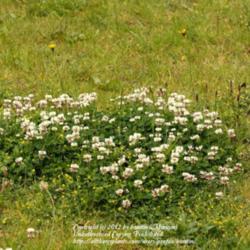
White clover (Trifolium repens) is a spreading perennial legume that often becomes a volunteer companion crop for lawn grasses. It also turns up in gardens, along with several other clovers that bloom pink or yellow. A little white clover in your lawn will help provide nitrogen, but in your vegetable garden only allow clover to grow between rows. Pull plants in early spring, when new growth begins. Small plants also can be cultivated out with a sharp hoe. In lawns, mow high and often to reduce reseeding. Apply a corn gluten herbicide in spring to limit the number of new clover seedlings in your lawn.
Weed Control TechniquesPulling. Most young weeds can be pulled from the soil. They will slide out most easily if you pull them when the soil is wet. Getting the root up is crucial, so think of the main stem as the root's handle, and grasp it as close to the soil line as you can. If you find that the weeds are breaking off at the crown as you pull, slip a kitchen fork, dandelion weeder, or similar tool under the weed, and pry and twist as you pull it up. Weeds that have taproots, such as dandelion and plantain, usually must be pried out. A flexible pair of waterproof gloves will keep your hands comfortable as you weed, and it's good to have a nice sitting pad, too. Let pulled weeds bake in the sun for a day or so before composting them. If pulled weeds are holding mature seeds, compost them separately in a hot, moist pile before using this compost in the garden.
Cultivating. Slicing and dicing weeds with a hoe works best when the soil is relatively dry, and the same goes for cultivating with a tiller. With their tops mangled and roots cut, most young weeds will quickly shrivel up and die. Be careful to cultivate only the top inch or two of soil or you may injure nearby garden plant roots and drag new weed seeds to the surface. A sharp hoe works much better than a dull one, so refresh the edge on your hoe with a steel file between weeding sessions. After using either a hoe or tiller to cultivate weeds, go back the next day to nip out any survivors. When battling perennial weeds, you can weaken the plants by chopping them down with a sharp hoe, but it's best to combine hoeing with digging to achieve good control. Never use a tiller in soil that is infested with bindweed, quackgrass, or other weeds that regrow from small pieces of root; they are easily spread by rototilling.
Reducing reseeding. Most weeds reproduce primarily from seeds, and the seeds of some weeds can remain viable when buried in the soil for decades. So it's essential to keep weeds from shedding seeds in the garden. Garden weeds that are neglected until they reach seed-bearing age can be lopped off near the soil line with pruning shears, a stout knife, or a string trimmer with a blade attachment. Cutting back perennial weeds again and again not only reduces reseeding, it also forces the plants to use up food reserves stored in their roots. In a garden that has gone hopelessly weedy, mowing it down promptly, raking out the seed-bearing debris, and starting over next year is a big step in the right direction. Mowing regularly helps keep weeds under control in lawns. When mowing lawns where seed-bearing weeds are present, collect the clippings in a bagger and dispose of them in a shady place.
Corn gluten herbicides. Powdered herbicides made from corn gluten keep crabgrass and other weed seeds from germinating and growing. They are typically spread on established lawns, but they also can be used in gardens where no seeds will be planted, such as in perennial beds. As the corn gluten degrades, it provides a small amount of nitrogen to the soil. Crabgrass begins to germinate at about the time that azaleas, dogwoods, and forsythias bloom, so spread corn gluten at that time for best results. Application procedures vary with the particular product; be sure to read and follow the directions on the label. Do not use corn gluten in newly seeded lawns, or in garden beds where you plan to sow seeds.
Image courtesy of Plant Stock Photos